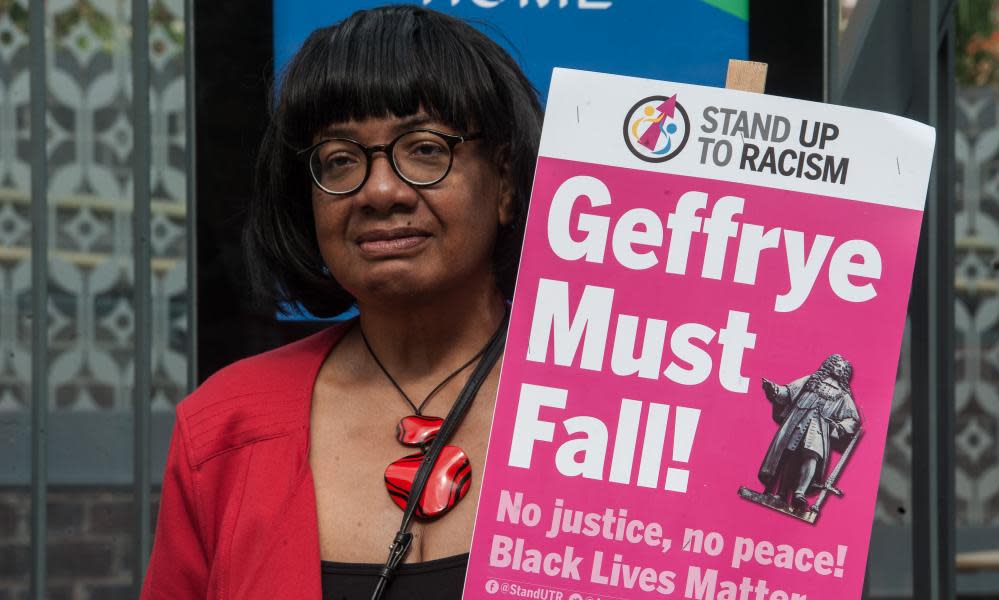Museum of the Home reopens to protests over statue of slave ship owner

The reopening of the Museum of the Home in London was met with protests on Saturday calling for the removal of a statue of slave ship owner Robert Geffrye following an intervention by the culture secretary to keep it in place.
The museum, in Shoreditch, east London, wanted to take down the statue of the 17th-century trader and former lord mayor of London, who made part of his fortune from the slave trade, from the front of its building.
Related: Museum of the Home review – home discomforts
But it decided not to after the charity’s trustees received a strongly worded letter from Oliver Dowden last summer, who has warned museums to “retain and explain” controversial statues.
As doors to the Grade I-listed building, formerly called the Geffrye Museum, reopened on Saturday morning following a three-year renovation, it was met with calls from residents, activists and politicians, including the Labour MP Diane Abbott, that “Geffrye must fall”.
In a speech outside the museum at the Hackney Stand Up To Racism protest, the MP for Hackney North and Stoke Newington accused its chair of trustees, Samir Shah, of giving in to government pressure.
Abbott said: “It’s not too late for Samir to show that he’s a little bit more principled than someone who when ministers say to him ‘jump’ he says ‘how high?’. So I’m calling on Samir Shah and the leadership of this museum to take down this statue, listen to the community.
“Take down this statue because, as we are saying today, Geffrye must fall.”
In a public consultation of more than 2,000 people, the majority of respondents said they were in favour of the statue’s removal.
The mayor of Hackney, Philip Glanville, said the museum’s board had “turned their back not just on Hackney, not just on anti-racism, but their own staff as well. We know their staff don’t want that statue to have that prominent place on Kingsland Road on this museum and everything it symbolises”.
He added: “It represents blood and murder and exploitation over centuries and it should not be standing in Hackney in the 21st century in a prominent position above this museum.”
It comes amid a growing row around controversial statues across the country – including the University of Oxford’s decision to keep a statue of British imperialist Cecil Rhodes at Oriel College, despite an independent commission backing its removal.
Speaking at the Geffrye protest, singer and activist Jermain Jackman said he is “traumatised every single time I walk past and see an individual, a statue of an individual, glorified, immortalised” on Kingsland Road.
“In a borough so diverse, one of the most diverse areas in the country, in a borough that elected its first black female MP, we still have a statue of a slavetrader in Hackney.”
Patrick Vernon, the social commentator and Windrush campaigner, said: “I wish that Boris Johnson and Dowden would come to a slave port and see the horrors of the likes of that man and many others that profited on the genocide of my ancestors.”
On its website, the museum cites “new legal safeguards” for historical monuments announced in January by the communities secretary, Robert Jenrick, adding: “In the light of this, the board believes that its original decision [“to keep and explain” the statue] is the only practical option for the foreseeable future.”
It adds that the board and museum are “continuing to review, discuss and explore options for the statue” and that it has installed a panel near the statue to tell a “fuller history of Geffrye, including his connections with the forced labour and trading of enslaved Africans, and acknowledging that the statue is the subject of much discussion”.
In a statement, the Museum of the Home said on Saturday that it “fully supports the public’s right to a peaceful protest” and that the debate over the statue “raises important questions”.
It added: “The museum is continuing to listen carefully to all the issues raised and is committed to being open about the history of Geffrye on site and online and to confront, challenge and learn from the uncomfortable truths of the origins of the museum buildings.
“Alongside the debate about the statue, the museum is committed to a transformative programme of structural and cultural change to become truly representative and inclusive, through our new galleries and displays, creative programming, partnerships and workforce.”


